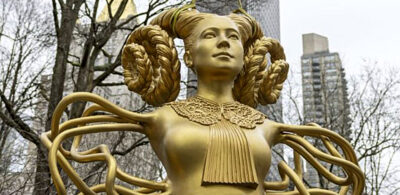Forget “isms” – except eclecticism
Forget “isms” – except eclecticism, was an October 1st, 2006, essay written for the Los Angeles Times by art critic Christopher Knight. He opened his article with the following statement: “Those discrete movements you studied in art history? They’re long gone. Today, it’s all about diversity – and quality, of course.” Knight moved out of the shadows and into the spotlight with his unmistakably postmodernist declaration. Avowing there are no more movements in art and all genres of art are now equal, Knight declared:
“Twentieth century art was long charted as an almost linear succession of “isms” – from Fauvism in 1905 to Abstract Expressionism in the 1950s – discrete movements that each expressed its own unitary view of things. The monolithic view that had congealed by the 1960s was a belief that the eye held dominion over art. That limited judgment was toppled by Conceptualism, which devalued everything visual in art and instead polished up the stature of ideas.”
Knight’s wholly ahistorical argument describes a world where history and art did not unfold linearly in reaction to historical circumstances. He blithely infers that 20th century western art movements were simply conjured up as matters of convenience, rather than being responses to societal, cultural and economic factors. He apparently wants us to believe that today’s art is somehow free from precisely these same overbearing pressures, and that it possesses no overarching politics. Knight insists that we are living in a period when “isms” have become a thing of the past, but he brazenly ignores the three biggest “isms” of our time, capitalism, globalism, and fundamentalism – all of which are exerting extraordinary power in shaping the direction of contemporary art.
Knight practically gloats over Conceptualism as a cleansing agent – a purer art based on theory and detached intellectualism. His cooing echoes the noises made by those art elites mocked in Thomas Wolfe’s 1975 sardonic screed against modern art, The Painted Word, a remarkably prescient and mordant denunciation of those who would devalue everything in visual art for the sake of theoretical gobbledygook. In his article, Knight advances the notion of the contemporary art world thriving in “robust artistic bounty,” due to what he calls the state of “pluralism” we allegedly find ourselves in, though he prefers to call this condition “eclecticism.”
According to Knight, eclecticism allows for the embracing of diversity “while also demanding quality.” But the postmodernist insistence on smashing and overturning aesthetic schools, styles and structures has delivered only a false model of diversity – that which is found in the fragments of an exploded monolith. As for the question of quality, that too will be left to the levelers, given that we are told one person’s subjective opinions and concepts regarding truth and beauty are as good as the next.
Driving home his point about the multiplicity found in today’s art scene, Knight wrote, “The extreme breadth of artistic diversity is so familiar and so routine as to border on invisibility.” His mentioning invisibility certainly applies to a great many artists, but not in the way he meant. A quick survey of the museum and gallery system in the United States reveals a stunning absence of works created by racial minorities, not to mention the abysmally low numbers of women found in the art world. Art critic Jerry Saltz, writing for the Village Voice, referred to the exclusion of women as “a failure of the imagination that amounts to apartheid.” So much for Knight’s vaunted “diversity.” Obviously Knight was pointing at the numerous range of styles and artistic disciplines competing for attention, but a single worldview can be presented in profuse ways. If we examine contemporary art for content we’ll find not diversity but a stunning conformity.
The missing piece in Knight’s diversity puzzle is an art that is both passionate about humanity and expressive of concerns for social justice. While such schools of art existed previously in the examples set by the Mexican Muralists, German Expressionists, and the Social Realists of 1930’s America, today there is little evidence of such art being included in Knight’s “pluralistic” art world. That’s not to say such artworks are not currently being created, just that they are effectively marginalized by the present-day gatekeepers who shape and manufacture public taste and opinion. There are some ideas in art so diametrically opposed that the discord between them will never cease, and as in every battle, there will be winners and losers. I speak here of the age old quarrel between advocates of art for art’s sake, and those, like myself – who insist art cannot be detached from social reality.
Knight comes close to a revelatory thought when he writes; “The idea that two or more kinds of ultimate artistic reality could comfortably coexist hasn’t always been in vogue.” Indeed, in some quarters the craze of facile aesthetic coexistence is fashionable, but fashion does not make for a set of indisputable facts. Thankfully, we can all take comfort in knowing that fashions melt away and are soon forgotten, so that what is now in vogue will soon be nothing more than tomorrow’s memories. At any rate, we should be exploring and expanding upon what is perennial in art, rather than chasing after the latest fads of the day.
Those long gone discrete art movements condescendingly dismissed by Knight, did not simply appear from the ether, they were logical and necessary developments that ruptured staid and conservative forces, advancing the history of art in the tumultuous process – we are sorely in need of such a movement today. Knight’s attempt to convince readers that the historic “linear succession of ‘isms'” has finally played itself out, and that the art world has forever been liberated by the forces of Pop and Conceptualism – bringing us to the current state of “pluralism” where anything goes and all things are equal – sounds remarkably like the now thoroughly discredited neo-conservative concept of “The End of History.”
American philosopher and leading neoconservative, Francis Fukuyama, wrote the 1989 essay The End of History, in which he stated; “What we may be witnessing is not just the end of the Cold War, or the passing of a particular period of post-war history, but the end of history as such: that is, the end point of mankind’s ideological evolution and the universalization of Western liberal democracy as the final form of human government.” Fukuyama interpreted the collapse of the Soviet Union as a total victory for liberal democracy, whereupon the human race would step up to the next epoch free of ideology, class conflict, and the linear march of history. There would be no more “isms.” Fukuyama’s hypothesis resonated in the postmodernist echo chamber where it completely dovetailed with the view of a globalized and pluralistic world community without a dominant center of power.
But the neocon bubble burst in February of 2006, when Fukuyama published another controversial essay titled, After Neoconservatism, as the third anniversary of the U.S. invasion and occupation of Iraq approached. The right-wing philosopher could no longer countenance the misdeeds perpetrated by the neocons in the White House, especially when it came to the debacle in Iraq. Fukuyama bluntly stated: “Neoconservatism, as both a political symbol and a body of thought, has evolved into something I can no longer support.” Suddenly history was once again on the march; if only we had such defectors from the postmodernist camp in the art world.
Knight’s unconvincing depiction of “eclecticism” carries as much weight as the tortuous and threadbare cock-and-bull stories told by Charles Jencks in his 1996 book, What is Post-Modernism? Jencks, a respected American architect, exponent of “radical eclecticism,” and leading advocate of postmodern plurality, asserted in his book that power has today become decentralized and non-hierarchical. I don’t know what world he’s describing, but it certainly isn’t the one I live in. Jencks writes of a modern epoch where “the information explosion, the advent of organized knowledge, world communication and cybernetics,” has done away with all class antagonisms, forever changing the workplace and replacing the proletariat with the “cognitariat” – or those whose job it is to manage information. Jencks wrote the following in his book:
“In the postmodern world, 1960 onwards, most of the previous relations of production have altered and the whole value system has been distorted. (….) Unlike the previous systems of production, where an aristocracy and bourgeoisie asserted power over a limited resource in order to exploit it effectively, the postmodern world is not owned, or run, or led, by any class or group, unless it is the cognitariat.”
Jencks’ claim that in our world, no class owns a limited resource or exploits that ownership to its advantage – is patently and demonstrably ridiculous. Forbes magazine assembled a directory in March, 2006, that listed some 800 world billionaires. Jencks would have us believe that these international captains of industry exercise no effective control over the world economy, and that their power has instead been superseded by a vague and ill-defined group he calls the “cognitariat.” As with the luster of Christopher Knight’s fairytale “eclecticism,” the veneer of Jencks’ idealized postmodern globalized world fades away to reveal the same old hierarchical class relations.





